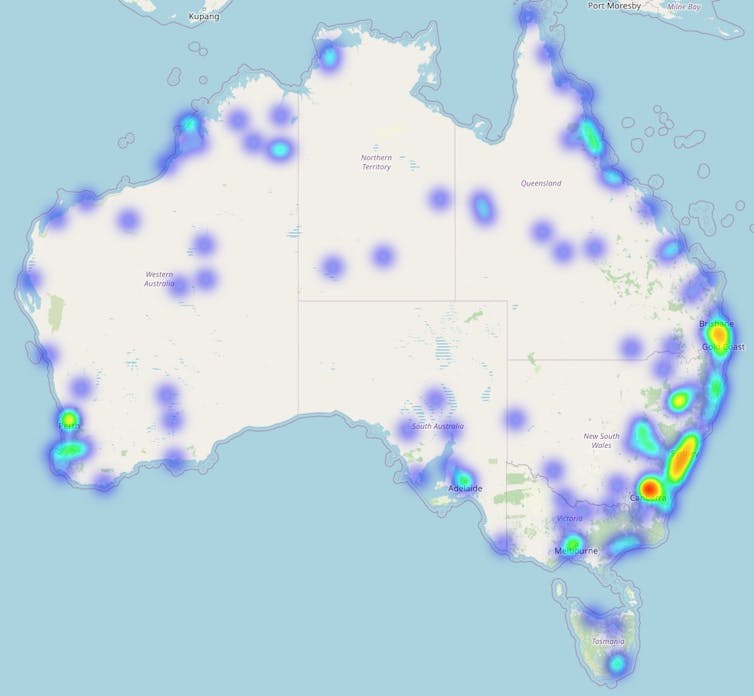Just 18 firms won 50% of federal Indigenous procurement spending: new study
- Written by Christian Eva, Research Fellow, POLIS: The Centre for Social Research and Policy, Australian National University
Australia’s decade-old Indigenous Procurement Policy[1] has been hailed by both sides of politics as a success[2] in Indigenous economic policy[3].
Started in 2015 as a way to address under-investment in Indigenous businesses when the federal government awards contracts, it’s maintained bipartisan support. In ten years, around 80,000 government contracts worth a combined A$12.6 billion[4] have been awarded to more than 4,400 Indigenous-owned businesses.
But my new research[5] – based on freedom of information requests released by the National Indigenous Australians Agency[6] – shows half of the $7 billion spent in the first eight years of the policy went to just 18 businesses.
It also found contracts have flowed mainly to businesses based in major cities – led by Canberra.
These findings are timely, as the federal government is already scaling up its targets[7] for Indigenous procurement between now and 2030, from 3% to 4% of government contracts.
What my research found
While the National Indigenous Australians Agency reports annual spending[8] under the Indigenous Procurement Policy (IPP) at an aggregate level, my new research is the first detailed public analysis of the IPP’s distribution of contracts.
My research[9], published this month in the Australian Journal of Public Administration[10], examines all contracts of $10,000 or more awarded to Indigenous businesses under the IPP from 2015–16 to 2022–23. These contracts represent more than 99% of the total value of contracts awarded.
In the first eight years of the IPP, from 2015 to mid-2023:
12,800 contracts worth $7 billion were awarded to more than 900 Indigenous firms.
6,415 or 50% of these contracts went to just 11 businesses
$3.5 billion – or 50% of the $7 billion – of these contracts went to just 18 businesses
47% of the total value was awarded to businesses of between 50% and 51% Indigenous ownership, with an additional 27% to businesses with unidentified Indigenous ownership status
5,272 contracts – or more than 40% of the number – and 30% of the value of contracts ($2.1 billion) were awarded to businesses in Canberra. That’s despite the Australian Capital Territory being home to just 1% of Indigenous Australians[11].

So a very small number of businesses, concentrated in capital cities and especially Canberra, have thrived under the IPP, compared to the much larger total.
That’s despite the fact that, by 2022, there were close to 14,000 Indigenous businesses[13] across Australia.
Why it matters
The IPP makes up only a relatively small slice of federal government goods and services purchases. But this shift has generated a substantial redirection of economic injection into the Indigenous business sector.
Yet because the scale of economic investment has been so large, it’s easy to lose focus on how this investment has been distributed nationally.
Indigenous business people, communities and politicians have raised questions about how widely the benefits of the IPP have been shared. For instance, as recently as last month[14], several senators raised concerns about issues of access to the IPP for many Indigenous businesses.
Changes now underway
The first decade of the IPP has shown the potential of public procurement as an investment in the growing Indigenous business[15] sector.
But even the federal government has acknowledged the policy needs to work better.
Earlier this year, the government announced[16] changes[17] aimed at “ensuring that the economic benefits of the IPP are genuinely flowing to First Nations Australians as intended”.
Those changes include new rules to strengthen eligibility criteria to access the IPP, starting from July 2026. They’re also aiming to make it easier to report non-Indigenous firms that fake or exaggerate the Indigenous ownership and management of their business to apply for government contracts – known as “black cladding[18]”.
Measuring success beyond raw numbers
Public procurement is a competitive process. As such, it never going to provide equitable opportunities for all businesses.
However, my new research shows the distribution of IPP contracts was highly concentrated until at least 2022-23, both geographically and in the number of businesses that won half of the contracts. That means other Indigenous businesses missed out on valuable economic opportunities.
As the IPP reforms continue to be made into 2026, it’s crucial the policy moves beyond just reporting the number and value of contracts awarded as its measures of success, to increasingly incorporate more Indigenous-defined measures of success for the IPP.
For example, this could involve introducing a greater focus on ensuring firms outside major cities[19] are also well placed to win procurement contracts. It could also include accurately valuing the social impact[20] of Indigenous businesses in the tender process.
The IPP has shown it has great potential. It’s time to make it work better not just for a federal government based in Canberra, but for Indigenous businesses right across the nation.
References
- ^ Indigenous Procurement Policy (www.niaa.gov.au)
- ^ success (www.indigenous.gov.au)
- ^ Indigenous economic policy (nit.com.au)
- ^ A$12.6 billion (nit.com.au)
- ^ new research (onlinelibrary.wiley.com)
- ^ National Indigenous Australians Agency (www.niaa.gov.au)
- ^ scaling up its targets (www.niaa.gov.au)
- ^ annual spending (www.niaa.gov.au)
- ^ research (onlinelibrary.wiley.com)
- ^ Australian Journal of Public Administration (onlinelibrary.wiley.com)
- ^ 1% of Indigenous Australians (www.abs.gov.au)
- ^ Who defines success? A critical analysis of the Indigenous Procurement Policy in Australia (doi.org)
- ^ 14,000 Indigenous businesses (theconversation.com)
- ^ as last month (parlinfo.aph.gov.au)
- ^ growing Indigenous business (iba.gov.au)
- ^ announced (ministers.pmc.gov.au)
- ^ changes (www.niaa.gov.au)
- ^ black cladding (www.afr.com)
- ^ outside major cities (www.niaa.gov.au)
- ^ social impact (theconversation.com)
Authors: Christian Eva, Research Fellow, POLIS: The Centre for Social Research and Policy, Australian National University







